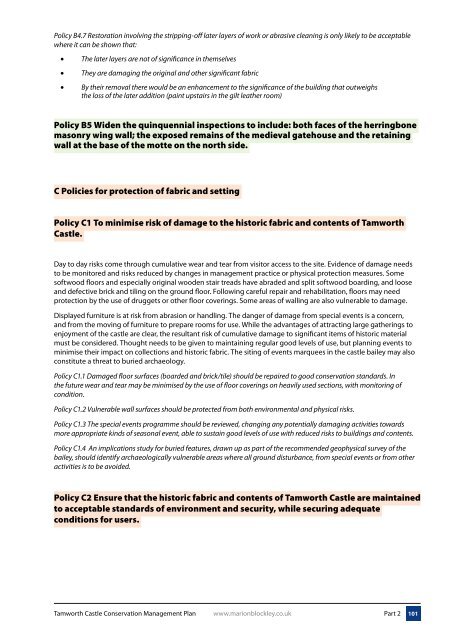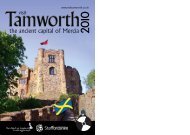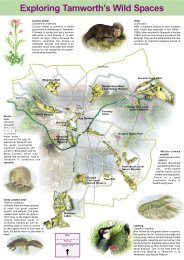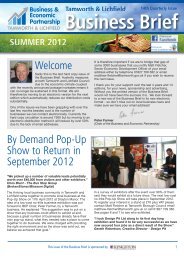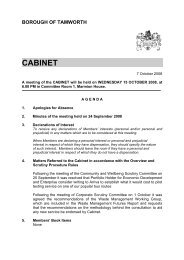Conservation Management Plan - Tamworth Borough Council
Conservation Management Plan - Tamworth Borough Council
Conservation Management Plan - Tamworth Borough Council
Create successful ePaper yourself
Turn your PDF publications into a flip-book with our unique Google optimized e-Paper software.
Policy B4.7 Restoration involving the stripping-off later layers of work or abrasive cleaning is only likely to be acceptable<br />
where it can be shown that:<br />
• The later layers are not of significance in themselves<br />
• They are damaging the original and other significant fabric<br />
• By their removal there would be an enhancement to the significance of the building that outweighs<br />
the loss of the later addition (paint upstairs in the gilt leather room)<br />
Policy B5 Widen the quinquennial inspections to include: both faces of the herringbone<br />
masonry wing wall; the exposed remains of the medieval gatehouse and the retaining<br />
wall at the base of the motte on the north side.<br />
C Policies for protection of fabric and setting<br />
Policy C1 To minimise risk of damage to the historic fabric and contents of <strong>Tamworth</strong><br />
Castle.<br />
Day to day risks come through cumulative wear and tear from visitor access to the site. Evidence of damage needs<br />
to be monitored and risks reduced by changes in management practice or physical protection measures. Some<br />
softwood floors and especially original wooden stair treads have abraded and split softwood boarding, and loose<br />
and defective brick and tiling on the ground floor. Following careful repair and rehabilitation, floors may need<br />
protection by the use of druggets or other floor coverings. Some areas of walling are also vulnerable to damage.<br />
Displayed furniture is at risk from abrasion or handling. The danger of damage from special events is a concern,<br />
and from the moving of furniture to prepare rooms for use. While the advantages of attracting large gatherings to<br />
enjoyment of the castle are clear, the resultant risk of cumulative damage to significant items of historic material<br />
must be considered. Thought needs to be given to maintaining regular good levels of use, but planning events to<br />
minimise their impact on collections and historic fabric. The siting of events marquees in the castle bailey may also<br />
constitute a threat to buried archaeology.<br />
Policy C1.1 Damaged floor surfaces (boarded and brick/tile) should be repaired to good conservation standards. In<br />
the future wear and tear may be minimised by the use of floor coverings on heavily used sections, with monitoring of<br />
condition.<br />
Policy C1.2 Vulnerable wall surfaces should be protected from both environmental and physical risks.<br />
Policy C1.3 The special events programme should be reviewed, changing any potentially damaging activities towards<br />
more appropriate kinds of seasonal event, able to sustain good levels of use with reduced risks to buildings and contents.<br />
Policy C1.4 An implications study for buried features, drawn up as part of the recommended geophysical survey of the<br />
bailey, should identify archaeologically vulnerable areas where all ground disturbance, from special events or from other<br />
activities is to be avoided.<br />
Policy C2 Ensure that the historic fabric and contents of <strong>Tamworth</strong> Castle are maintained<br />
to acceptable standards of environment and security, while securing adequate<br />
conditions for users.<br />
<strong>Tamworth</strong> Castle <strong>Conservation</strong> <strong>Management</strong> <strong>Plan</strong> www.marionblockley.co.uk<br />
Part 2<br />
101


